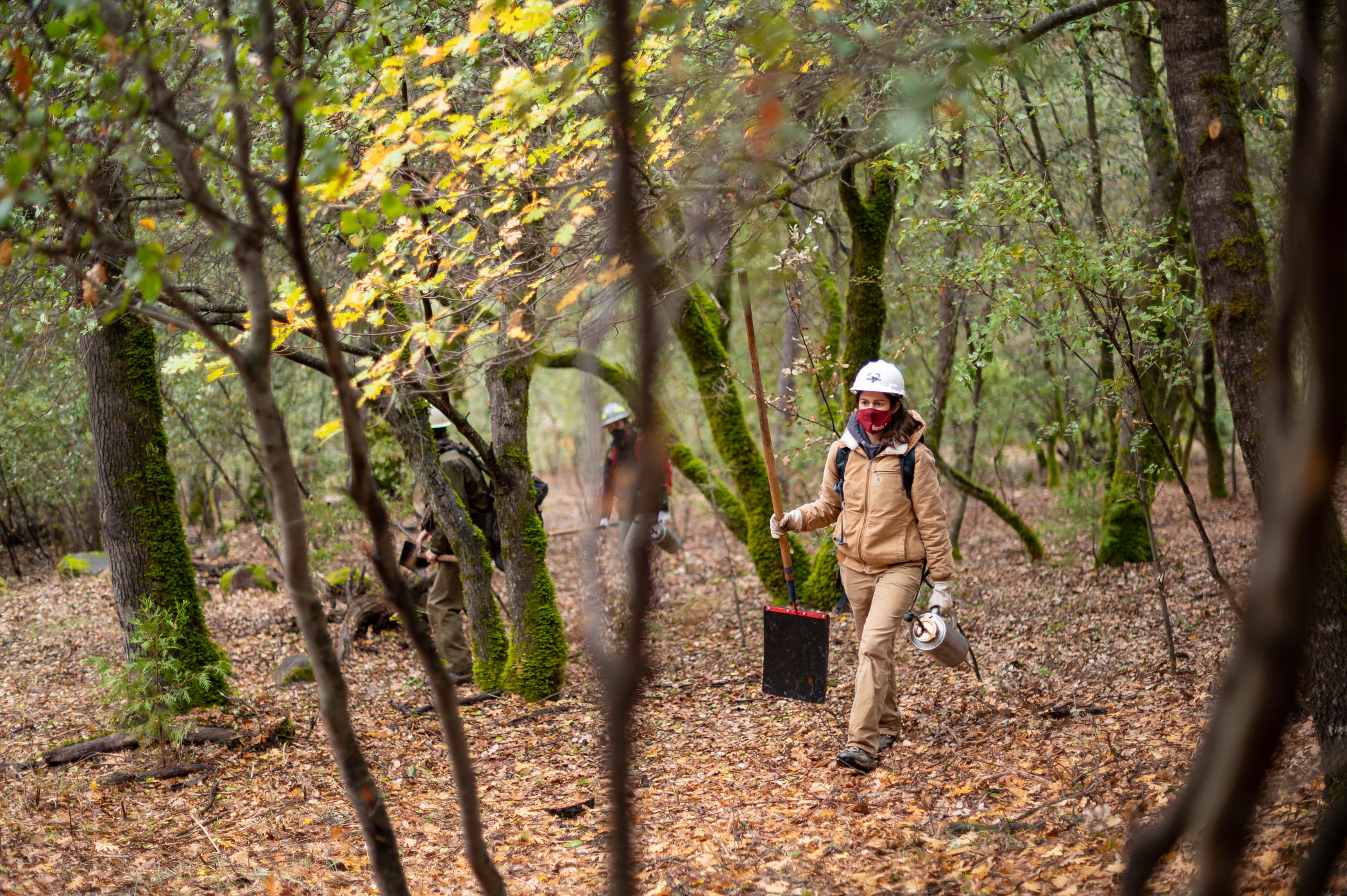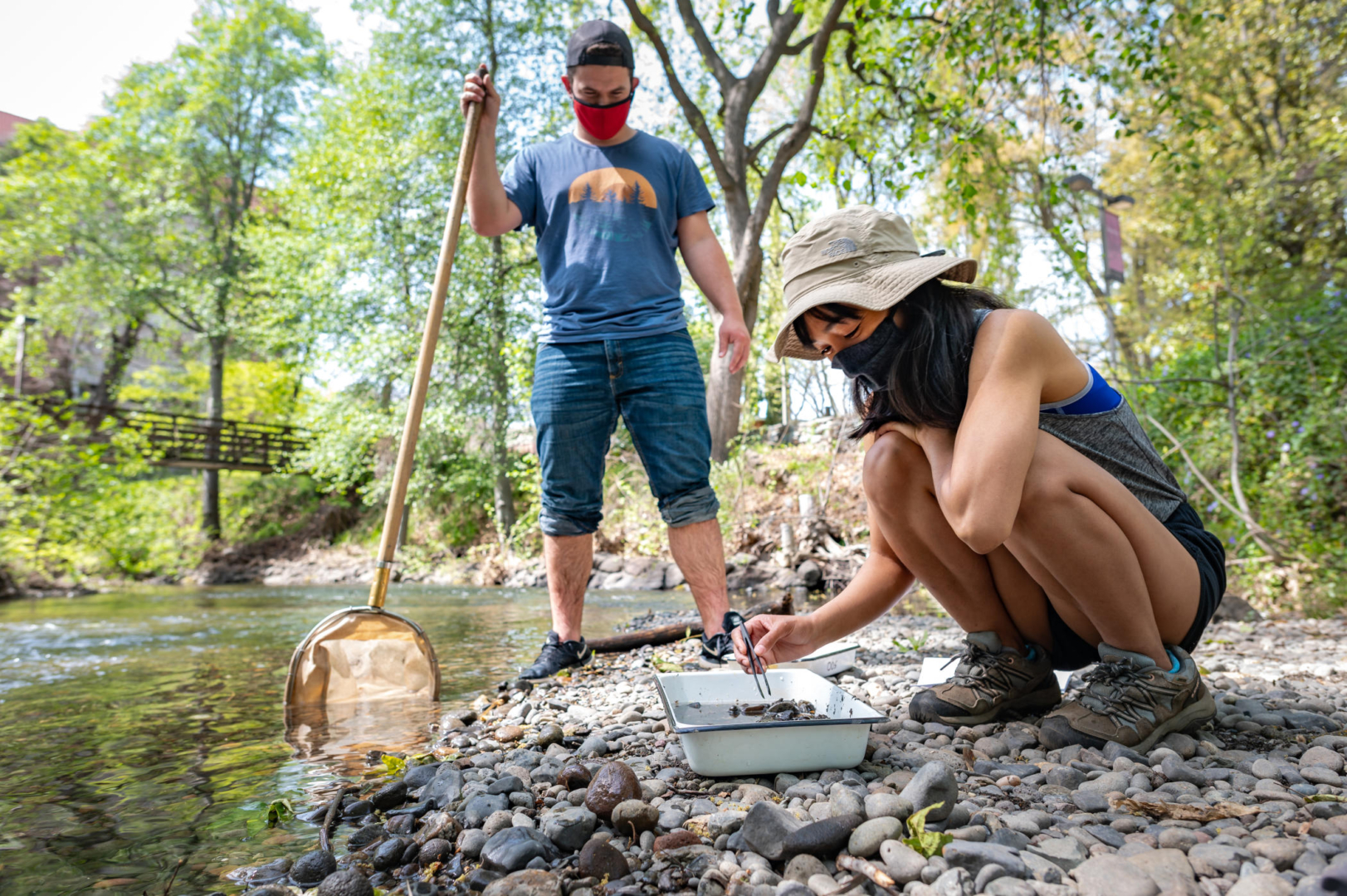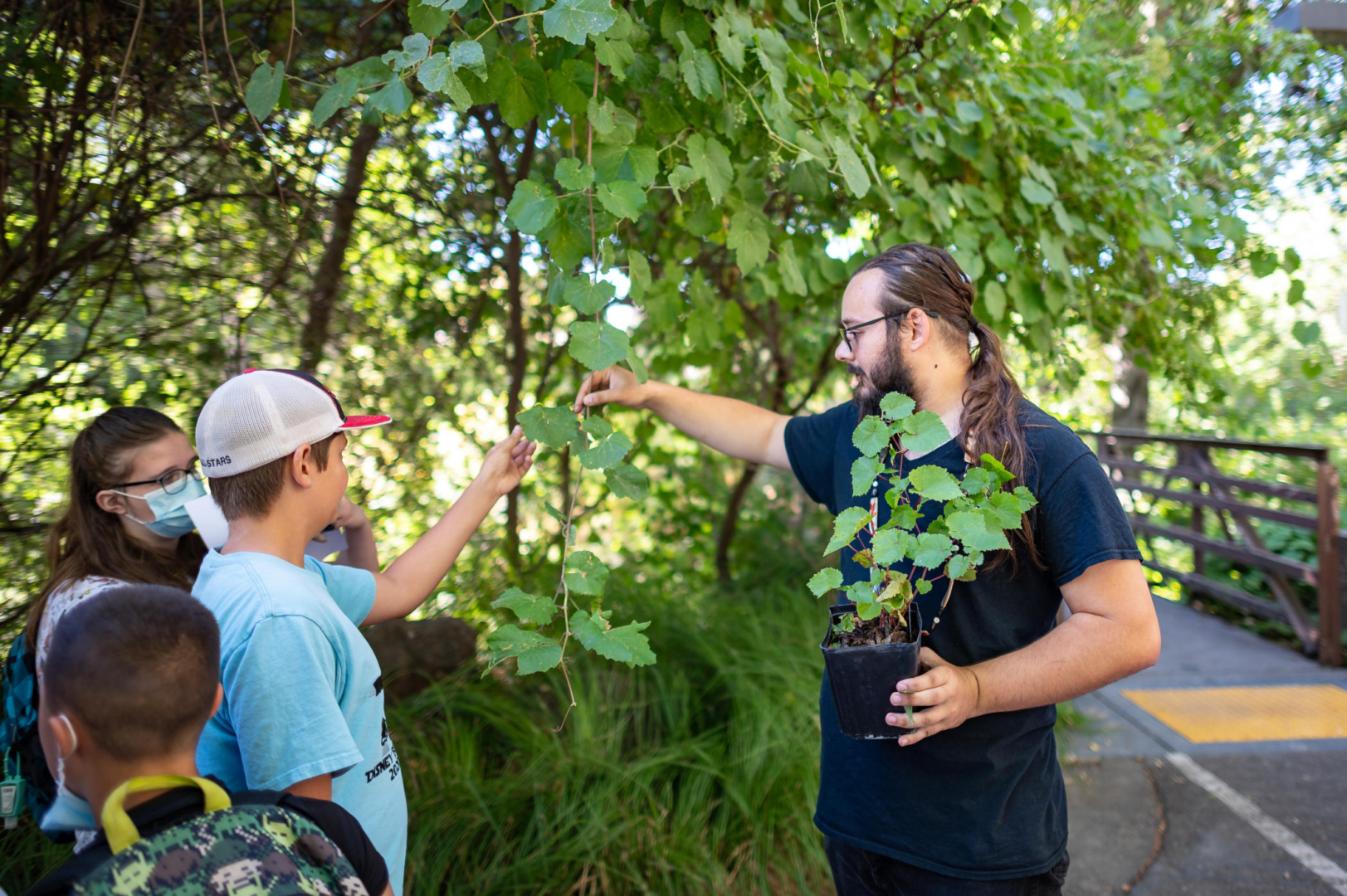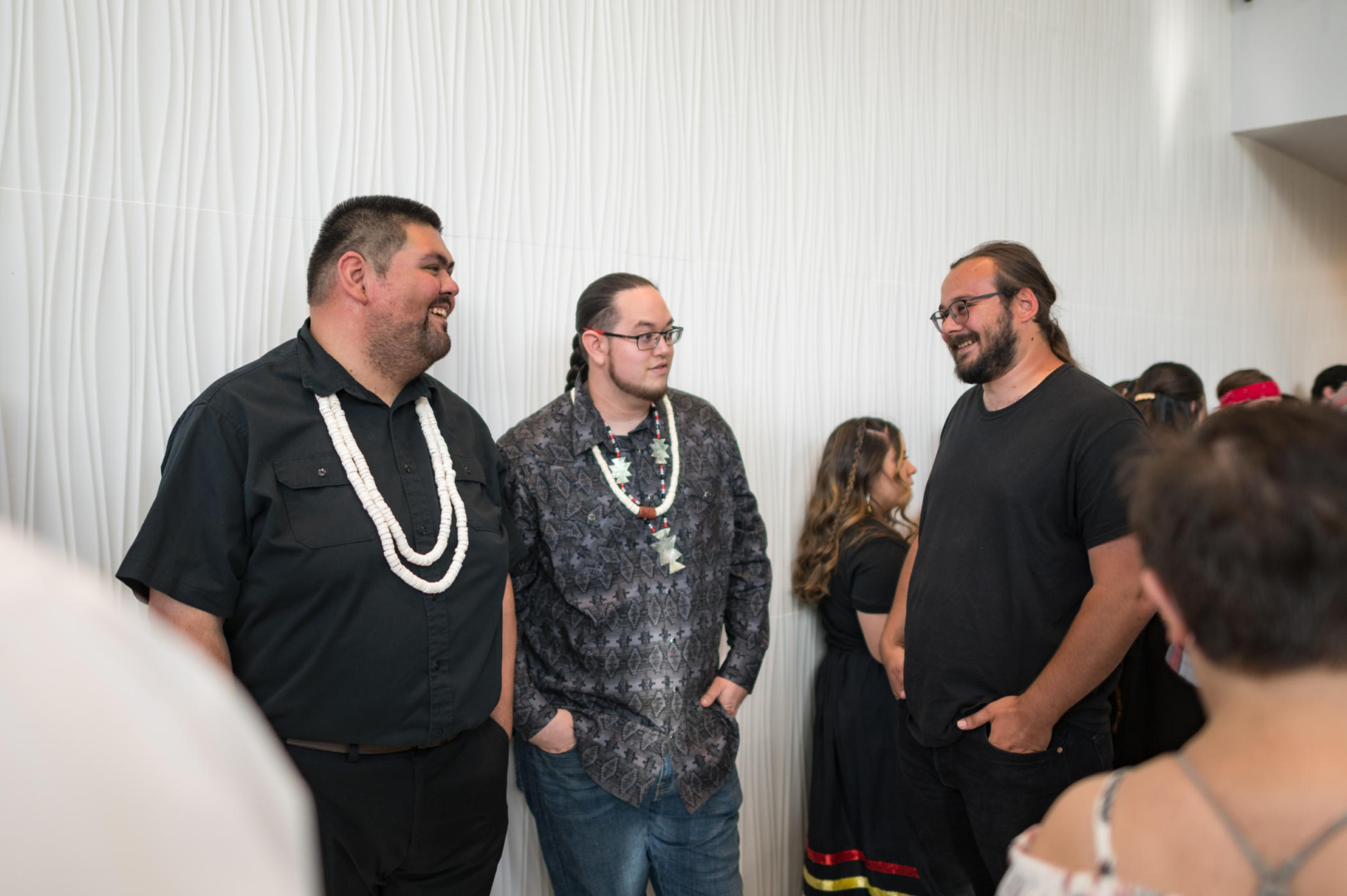Innovative Program Strives to Protect the Wildlands of the West

Karina Haddad and fire practitioners use a driptorch to train for a variety of aspects related to forest management and prescribed fire training at Big Chico Creek Ecological Reserve (BCCER) on Saturday, November 6, 2021 in Chico, Calif. (Jason Halley/University Photographer/Chico State)
If you have ever found yourself in the North State admiring its ancient Valley Oaks, traversing golden hills speckled with native perennials, or standing in the clean streams cutting through its valleys, you have experienced the living results of countless people who have worked to protect, maintain, and preserve this unique landscape.
Yet, the health of the wildlands of the west is increasingly threatened.
Effects of climate change, such as wildfires, droughts, and warmer temperatures, have accelerated a critical need for experienced and multifaceted land stewards to lead the future of protecting its native ecosystems.
A small hub of passionate graduate students and faculty at Chico State decided to take an active role and has since created one of the most effective and unique land management graduate programs in the California State University system—ultimately redirecting the future of wildland management in California.
“I view the challenges in land stewardship in the American West and beyond as our generational challenge,” stated Eli Goodsell (Criminal Justice, ’07; MA, Environmental Policy and Planning, ’11), director of the Big Chico Creek Ecological Reserve (BCCER). “We are 180 years behind in land stewardship since restricting Tribal members from leading in the protection and preservation of our wildlands. I am here because I believe that higher education is going to play a large role in changing that.”
In 2020, the Interdisciplinary Studies: Wildland Management graduate program began enrolling students for the first time. The program’s enrollment is once a year, which creates a tight-knit cohort of students moving through projects alongside each other in vastly different but interconnected disciplines. Students train in forestry and land management including policy, research, prescribed burns, forestry, and education.

In only its second year, word of the program is spreading. As members of the first cohort graduated this spring, students from the University of Washington, University of California, Santa Barbara, and Cal Poly San Luis Obispo have enrolled this year, understanding that it is one of a kind.
Successfully defending his thesis this spring, He-Lo Ramirez was the first student to complete the program, followed shortly after by Cole Morales. Both alums are members of the Tribes of the Maidu people—the native people to the Butte County and surrounding areas—and they both share a passion for pursuing policy to protect the land, as well as educating others about what it means to be an environmental steward.
With a diverse educational background, He-Lo (Biology, ’19; MS, Wildland Management, ’22), a member of the Mechoopda Tribe, consistently works toward initiating a greater shift in indigenous education. His culminating project focused on the need for place-based, culturally relevant outdoor education for Native youth, and in turn, he developed a multisubject curriculum to restructure education to accurately teach Native youth about their own history and culture.
According to He-Lo, the opportunity to arrange a master’s program around his aspirations changed the trajectory of his goals.
“Through this program, I was able to manage wildlands utilizing a holistic approach to benefit the whole community at large, but more specifically, my own community who are the traditional land stewards and land managers of the Big Chico Creek and Butte Creek watersheds,” he said.
The experience was both comprehensive and incredibly diverse, he said.
“This interdisciplinary program allowed me to receive experience as a wildland firefighter, supervise land stewardship crews, engage in outdoor education with Native youth, educate non-Native people on the history of Butte County, engage in consultation with Tribal governments, and gain experience through boots-on-the-ground land management practices,” He-Lo said.

After completing his degree, He-Lo now serves as the director of environmental planning and protection for a local Tribal government. He says his goal in this position is to restore and conserve the Indigenous cultural landscape of Northern California while supporting the education of local Native youth in indigenous environmental science.
Allowing students of all educational backgrounds to gather valuable work experience in multiple fields through hands-on education, this graduate program creates an enriching environment that is hard to replicate in a traditional disciplinary degree path, Goodsell said.
“What makes the program so unique is its true interdisciplinary nature,” explains Goodsell. “Students working on prescribed fire burn curriculum are working right alongside natural scientists measuring the effects of prescribed fire burns on seed banks, who are working alongside students investigating invasive species removal and mapping curriculum.”
Whether running agencies, starting programs, or writing and lobbying policies, the vision is that when they graduate, they will have a rich background and a collaborative vision to drive this work forward.
“It’s not going to take one person from one discipline or background to make a change,” says BCCER Coordinator Gary Day (Biological Sciences, ‘14). “It’s not just people who work the forest, but those who work the lobby, the classrooms, and the fields. It’s going to take all of us collaborating to make things better.”
Day founded the program as his own graduate project in the recreation administration program. His intention was to create a hands-on, multifaceted education that builds experience while earning a degree. The majority of education takes place on the BCCER, a protected 7,835 acres of ancestral land to the Mechoopda Indian Tribe in the Chico foothills, less than 15 miles from Chico State’s main campus.
Cole Morales (Recreation, Hospitality, and Parks Management, ’20; MS, Wildland Management, ’22), a member of the Susanville Indian Rancheria, also chose to focus his thesis on a project that would support his Tribe. He ultimately focused on natural and cultural resource management for Native American Tribes and collaborated with two Tribes using geographical information system (GIS) to map cultural and natural Tribal resources, as there has been a significant amount of ancestral land destroyed by wildfires within the last five years. According to Morales, the program gave him the freedom to shape his own path in line with his passion and talents—and represents a platform for future voices.
“Programs such as these provide an opportunity to give Indigenous communities a voice in applying traditional land management practices to their traditional homeland,” he explained. “Indigenous knowledge is crucial for the future of land management; this program has allowed me to explore avenues where I can apply my education in order to support and be a voice for my Native community.”
Morales is currently working as a Tribal relations specialist in the University’s Office of Tribal Relations, a department that provided significant support for both him and He-Lo throughout their college careers. He aims to work toward advancing the priorities of his Tribe through policy-making and grant writing for Federal Indian Law, as well as incorporating the use of a GIS database for his own Tribe’s resources.
He-Lo and Morales expect to be followed by a landslide of well-rounded land stewards: Upcoming graduate Karina Haddad developed an entire program capturing video of endangered species and mammalian predators on ecological reserves; student Ashleyann Bacay is gathering and analyzing quantitative and qualitative data on the effects of prescribed burns, and investigating professional views on the importance of prescribed fire and fire policy; and Francisco Medrano Jr. is developing a restoration plan for his local tribe around stewarding culturally significant flora species post-catastrophic wildfire.

“Not only am I completely impressed and have so much pride in Cole and He-Lo being the first to complete the program, I am inspired by all of our graduates,” Goodsell said. “These students are incredible, and they will go on to change the future by developing projects that protect endangered species, improve infrastructure, educate youth, and better environmental procedures—and this is largely due to the invaluable collaboration and shared knowledge between graduates.”
Land stewards like He-Lo, Morales, and those to come next are the beginning of that generational shift Goodsell wants to see. He and Day share the goal to give students the foundation to emerge from the wildland management program as well-informed advocates—leading the future of how we care for the land we occupy.
“Directly due to colonization, during the last 180 years, the biodiversity of California has decreased, species have become extinct, habitat has become highly fragmented, and massive destructive wildfires are common now,” He-Lo explained.
“The wildland management program will train the next generation of land managers who recognize Indigenous science as a valid form of knowledge, the value of including Indigenous communities in land management decisions, and the role of good fire on the land.”
If you are interested in learning more about opportunities in the MS in Interdisciplinary Studies: Wildland Management program, reach out to the BCCER today by emailing bccer@csuchico.edu. Every Monday, Wednesday, and Friday, the BCCER emails students on career, educational, and internship opportunities in a wide array of environmental management.


